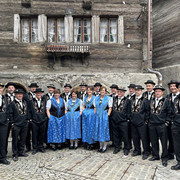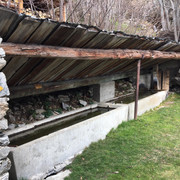- Photos & Map
How would you like to arrive?
- Description
- Good to know
- Nearby
- 8:00 h
- 27.29 km
- 764 m
- 904 m
- 645 m
- 1,086 m
- 441 m
- Start: Hohtenn
- Destination: Naters
The "Lötschberg", as we call the BLS railway here, is one of the most important feeder railways to the Upper Valais. The Lötschberg southern approach can be walked from Hohtenn to Naters. In Naters, the new "Lötschberger" trail leads to the Museum of the Swiss Guard and the fortress.
For the complete route of the Lötschberger from Hohtenn to Brig you should reckon with a walking time of around 8 hours.
The route can also be divided into several shorter stages.
Good to know
Pavements
Best to visit
Directions
Tour information
Familiy-Friendly
Stop at an Inn
Equipment
Directions & Parking facilities
From Western Switzerland: A9 Lausanne - Vevey, or North Western Switzerland: A12 Bern - Vevey: A9 - Sierre: main road Sierre - Brig
From the northwest of Switzerland: A6 Berne - Thun - Spiez: main road Spiez - Kandersteg (car transport Lötschberg tunnel) - Goppenstein - Gampel - Brig
From Eastern and Central Switzerland: Andermatt - Realp (year-round Furka car transport; in summer via Furka Pass) - Oberwald - Brig
From Ticino (in summer): Airolo - Nufenenpass - Ulrichen - Brig
Or via Centovalli - Domodossola - Simplon pass - Brig
From Italy (Aosta, Mt. Blanc tunnel): Aosta - Grand Saint Bernard tunnel (over the Pass in summer) - Martigny: A9 freeway - Sierre: Sierre - Brig main road
Or via Domodossola - Simplon pass - Brig
You can find the SBB timetable at: www.sbb.ch
Author´s Tip / Recommendation of the author
- The Guard and Fortress Museum in Naters is well worth a visit
- Enjoy the beautiful and unique view over the entire Rhone Valley
Safety guidelines
Despite the "untraceable" marking of the hiking trails, we recommend for safety reasons to always have an appropriate hiking map with you, so that you can quickly find a safe area in case of a thunderstorm or emergency, for example.
Especially in autumn, you should also be aware that leaves lying on the ground can hide bumps, roots, stones or holes in the path. After storms, trees can still fall over or branches can fall down. Especially in adverse weather conditions, muddy and slippery passages can occur on natural paths. You have to expect this kind of path obstruction when you go on a hike.
Not all rocks or precipices are secured with ropes or railings. In some cases surefootedness is required. If you think that certain sections of the trail are not passable for you, you should avoid them.
Nearby












